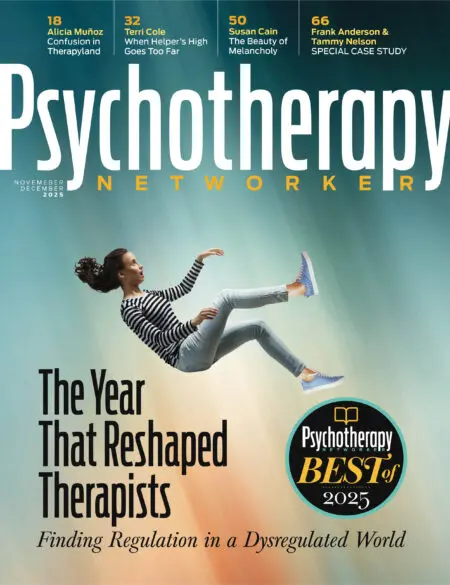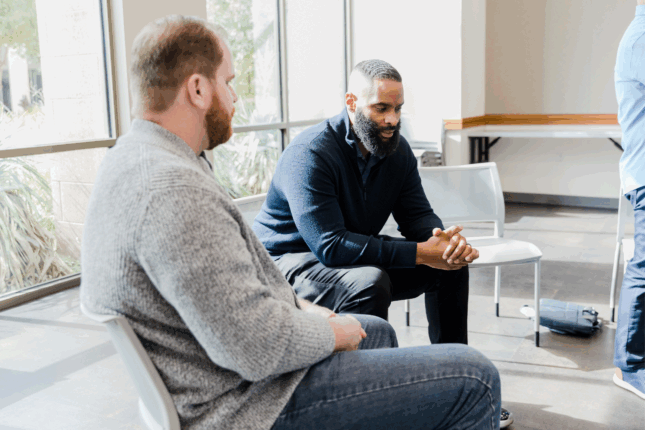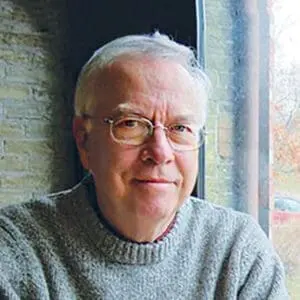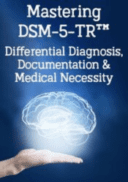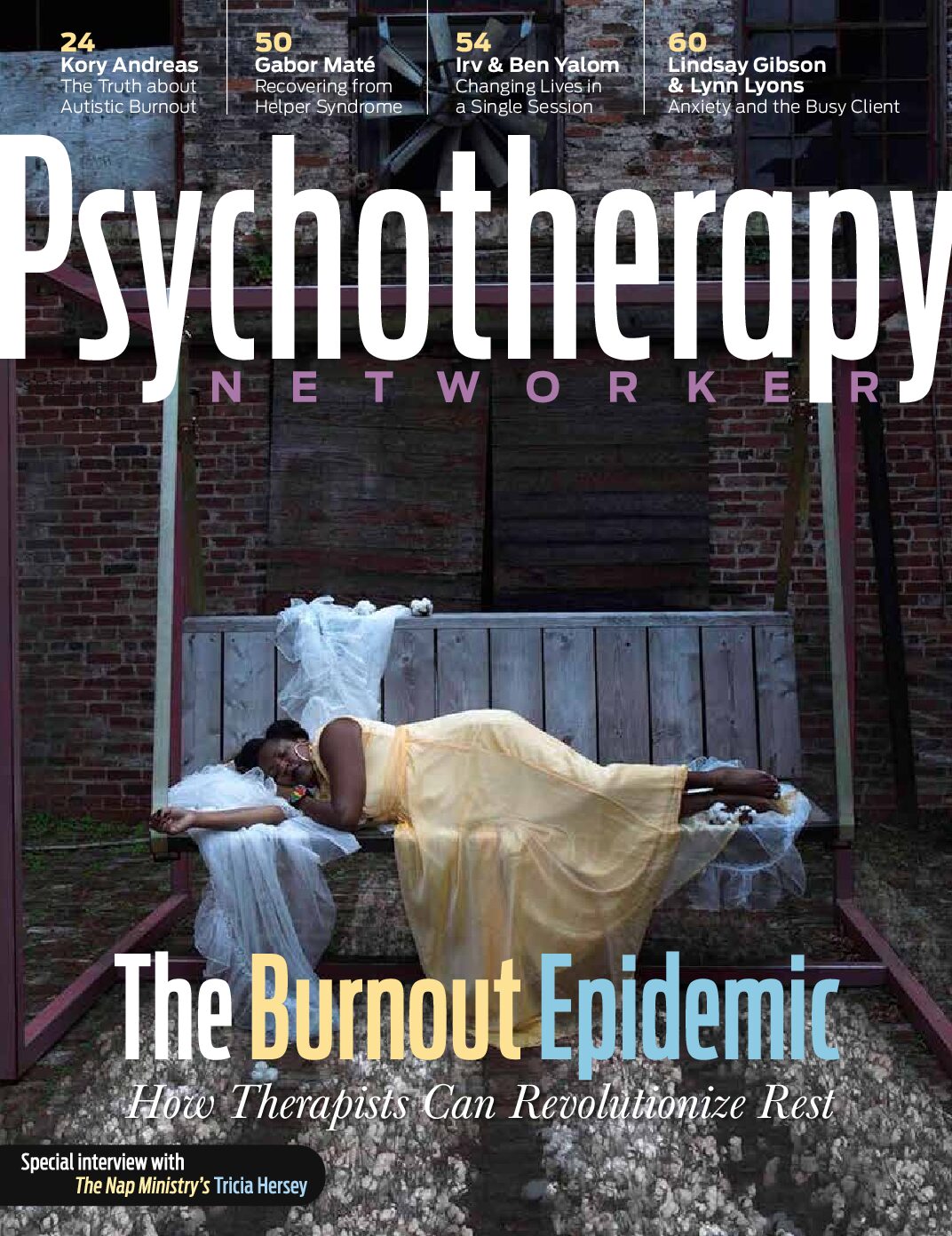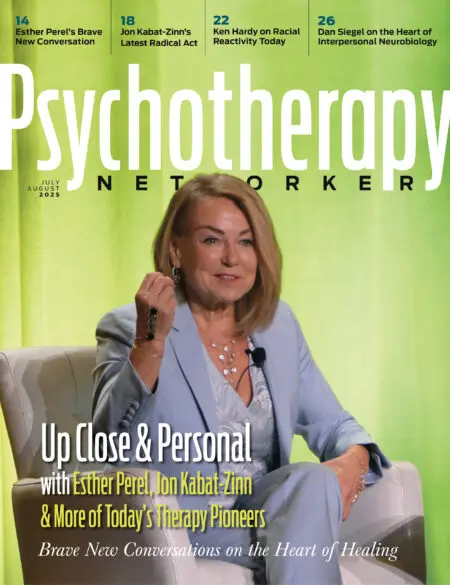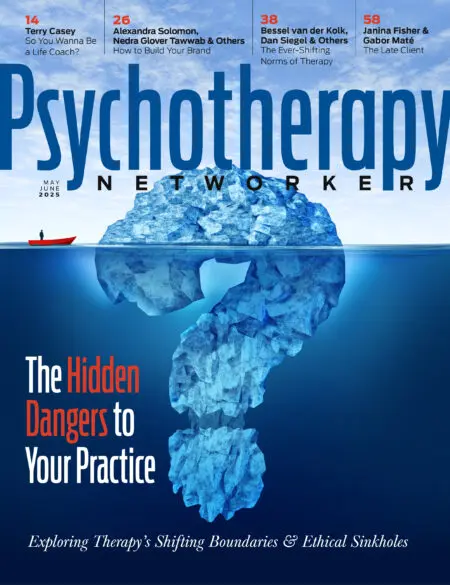Remember the racial reckoning sparked by the police murder of George Floyd in the summer of 2020? From almost everywhere, we heard calls for immediate, transformative change in policing and other institutions, and we vowed to have more open conversations about race in our institutions. Five years later, national attention has moved on to AI and tariffs, while DEI trainings quietly go away. Far from a consensus about policing in the Black community, we see a growing segment of the country denying that officer Derick Chauvin was even responsible for Floyd’s death. It’s dizzying and dangerous.
What can therapists do other than tend to the clients in their offices, one at a time? Might we contribute to the larger issue as what I call “citizen therapists,” bringing our clinical skills to bear on social problems? In my case, it’s my couple therapy skills where I know how to promote healing by helping people access their best selves in the face of intractable conflict. Although I was already in the fray as a citizen therapist when George Floyd was murdered, my work took a new, meaningful direction as we tried to navigate the ensuing moral panic over race and policing.
I recount the story below in hopes that other therapists might see how we can bring about social change amid the good guy/bad guy dichotomy that dominates our current milieu.
****
In the summer of 2016, days after Philando Castile was killed by police during a traffic stop in my neighborhood—his girlfriend and her young daughter watching, recording—I dropped in on my longtime colleague Guy Bowling at his office. We’d worked together for years on fatherhood initiatives in Minneapolis. Guy is upbeat by nature, someone with resilience in his voice even when he’s tired. But this time he looked worn out. “I’ve got outrage fatigue,” he told me. That caught my attention.
Guy, who is Black, was grappling with what so many Black men in America feel after police shootings: grief, fear, and the sense that no amount of caution guarantees safety. “This time,” he said, “the brother did everything right. And he still got killed.” There was nothing he could tell his son that would make it make sense.
I listened. I didn’t have a response. I’m a white family therapist, not a racial justice activist or a policing expert. I’d been watching these events like everyone else—sick at heart, angry, and unsure what someone like me could do that wouldn’t be symbolic or performative.
Then Guy asked a question that changed my life: “Do you think the Citizen Health Care model could work here?”
Over the years, I’d developed and tested what I call Citizen Health Care—community-based initiatives where everyday people come together with professionals to address the chronic dilemmas in their lives. We’d done it with middle-class parents facing pressures to overschedule kids, American Indians demoralized by widespread diabetes, and low-income fathers trying to reclaim their roles in their children’s lives. Guy had been part of several Citizen Health Care projects. The idea was always to create a small group of people with lived experience, connect them with professionals, help the group build trust and insight, and then support them in offering something back to their communities.
But apply it to police officers and Black men? I spun out an idea: bring together a small group of Minneapolis police officers and Black men from the community, build trust over time, and then see if they could so something together to bridge the gap between police and the community, and promote safety for everyone.
Getting Started
Guy and I both agreed: if this project was to have any chance, it had to include male officers from the Minneapolis Police Department and Black men from the community. That was the volatile flash point, where the hurt, the fear, and the stereotypes collided. We could find community members through our existing networks. But the officers? We had no direct connections. And no margin for error. One misstep, one whiff of an anti-police agenda, and the project would die before it began.
I called Sylvia Kaplan, a friend and former therapist who was deeply connected in Minneapolis politics. She invited another contact to lunch with me—someone who also understood the inner workings of the city. I laid out the idea: a long-term, cocreated group of officers and Black men, not to hash out policy, but to build real relationships and decide together what could be done. They listened and then gave me pointed advice: “Don’t start with the police chief. Start with the police union. The officers won’t trust anything that looks like it’s coming from the top.”
That’s how I found myself nervously calling the administrative assistant to the head of the police union. I hoped she could get my pitch in front of the union leader. But after I explained the project—how it would involve long-term dialogue, personal storytelling, and joint action—she surprised me. “This sounds important,” she said. “Send your email, and I’ll make sure he sees it.”
Within days, I was meeting Officer Dave O’Connor, a union board member, at a coffee shop. He brought a police colleague. I told them what the project wasn’t: It wasn’t a listening session where officers sit silently while people yell at them. It wasn’t a program with a pre-written agenda. And it wasn’t a one-off. We would meet regularly for a year before taking action. We would start with stories, not solutions. We would build trust before trying to change the world.
They listened. They didn’t say yes right away, but they kept nodding. This was a different approach to a gap that troubled them. “We’ll run this buy some of our colleagues and see if there are green lights before getting the chief involved,” Dave said.
When I finally sat down with the chief, she’d brought along her community liaison, Sherman Patterson, a respected Black leader. I told the story of being on the streets of Washington, D.C., in 1968 after Martin Luther King’s assassination. I remembered the police looking helpless as the looting intensified, which showed how little the police can do without public support. That, I said, was what our project was about: forging partnerships between law enforcement and communities, so they weren’t trying to go it alone.
She was in. She tasked Sherman with helping us recruit officers. We were off the ground.
Finding a Rhythm
We launched with seven Black community members and six officers—five white, one Black. We decided to meet every other week, alternating between a police training facility and a neutral community space. The goal was simple but ambitious: to build relationships strong enough to hold hard truths and then act together from that foundation.
The first two meetings were cordial but tense. No one let down their guard. The officers showed up in uniform. One community member told me later that he expected to be frisked upon entering the first meeting. (He was not.)
Our third meeting was a turning point—for better or worse, I wasn’t sure at the time. One of the senior officers, a Black man, had asserted authority at the second meeting. When I tried to redirect two group members from an argument going nowhere back to our agenda, he cut me off with “Let them finish.” I felt the whole process slipping away. Too much heat too soon could derail us. If this turned into a series of arguments about who was right and who was to blame about police shootings, it would collapse under the weight of mistrust.
I didn’t sleep well the night before our third session. I knew I had to win what family therapist Carl Whitaker called “the battle for structure.” I had to be able to use my judgment as the group facilitator without being derailed.
When we gathered, I laid it out. I told them I needed their trust to facilitate. Not to control what they said, but to shape how we moved through the process. “If we don’t have structure, this can blow apart,” I said. “It’s like therapy. You need safety before you go into the deeper stuff.”
The pushback came fast. One community member said, “We’re tired of always being told how to behave in groups. We want to speak freely and not be shushed.” The senior officer stayed quiet but watchful.
I held my ground. Fortunately, I knew the community member well. “When have I ever shushed you?” I said with a chuckle. “You wouldn’t let me if I tried.” He laughed. “If you want to push back because you think I’m cutting you off, look me eye and tell me yourself,” I said to him and the group, “but don’t be sticking up for other people by saying ‘Let him finish.’” That was my signal to the senior officer, who let me know he heard me by quietly smiling.
That cracked something open. The tone shifted. A few group veterans—people who’d worked with me before and trusted my skills—spoke up in support. “I wouldn’t come to this if Bill wasn’t leading it,” one man said. “But yeah, maybe this group needs a different rhythm.” Another chimed in: “Let’s try it. If it feels wrong, we’ll adjust.”
We agreed to a basic structure. I’d bring an agenda. We’d follow it unless someone objected up front. If a topic needed more time or depth, we’d set it aside and revisit it later. And everyone would get a turn to speak.
The group took a collective breath. The session ended with a white officer saying, “When you see me in uniform, you probably think I’m just another cop. But now you know me. I’m a person, not a threat.” A community member replied, “And when you see me walking down the street in dreadlocks, maybe you won’t think I’m one either.”
We weren’t healed. We weren’t unified. But we had a rhythm. And we had momentum.
Stories, Stereotypes, and Kinship
We committed to storytelling as the foundation of our work. No cross-talk—just each person, five minutes on the clock, answering questions we’d agreed on: What were your early experiences with police officers? What were your early experiences with Black men? What were your early experiences with white men? The stories poured out.
The officers often spoke of admiration. “My dad was a cop,” one said. “I always wanted to help people.” Another remembered doing ride-alongs in high school and feeling called to serve.
For the community members, the stories were different. Many spoke of fear and humiliation—being stopped, questioned, sometimes roughed up. One described how an officer who once arrested him later helped him turn his life around. “He taught me how to box,” he said. “Saved me.”
Then we turned to our fathers. The contrast hit hard. Most of the officers had involved dads who modeled order and discipline. For many of the community members, their stories were steeped in pain—absent fathers, abusive ones, or longed-for ones they never knew. “But I’m not him,” one man said. “I’ve raised my kids different.”
The white officers seemed reluctant to talk about racist attitudes when they were growing up. So I decided to talk about growing up in 1950s working-class Philadelphia, hearing the N-word regularly. I shared how my Archie-Bunker-type father had negative, stereotypical views of Black people in general—and yet, when I saw photos of his retirement party, most of the guests were Black coworkers. “Where are the white people?” my wife asked, half-joking. My parents were perplexed; they hadn’t noticed. It was complicated, like all of us.
I could feel the Black men in the group exhale a little at that moment. It wasn’t confession for its own sake. It was making visible what they already knew: that racism isn’t always about open hatred—it’s in the air, in the jokes, in the silences.
The white officers were younger than me. They spoke about integrated schools and Black friends. I wasn’t sure if the difference was generational, or if they were holding back. But we weren’t scoring points. We were building a shared history.
Through those stories, something strange began to happen: the officers and the community members started seeing themselves in one another. Not completely. Not evenly. But it became clear that both groups were, in the public eye, often seen through a single lens.
“We’re both stereotypes,” one officer said.
That moment hit. Black men and police officers—two groups often portrayed as dangerous, volatile, dehumanized. Both blamed for systemic failures far bigger than any individual. That insight began to reshape our group identity. We weren’t adversaries sitting across from each other. We were men who knew what it felt like to be feared, misjudged, blamed. We didn’t all agree on the causes—the white officers never came around on the term “white privilege,” but the bonds of something deeper—maybe even brotherhood—started to take root.
A New Narrative
One community member stepped forward with an idea: Let’s write a shared narrative. Not a mission statement, not a press release, but a coauthored story about what we believe, what we’ve learned, and what we want for our community. Something we could share with others.
It sounded simple. It wasn’t. We spent months wordsmithing. Every sentence mattered. We weren’t writing from a single worldview. Even terms like white supremacy had sparked long debates. The officers bristled—it reminded them of Apartheid. The community members pushed back: How else do we name what we’ve lived? Eventually, we found language we could all agree on. We aimed for shared meanings, not slogans.
We called our narrative statement a Partnership for Community Safety. Not just better policing. Not just more personal responsibility by community members. Something broader and deeper: a partnership with mutual accountability. We agreed: you can’t police your way into a safe community. You need trust, opportunity, and stability. That means jobs, housing, healthcare, and education. And it means police officers and Black men seeing themselves as stakeholders in the same project, not adversaries in opposing camps.
We began sharing this narrative in community forums, one with high school students and another with a fatherhood group. We asked them the same questions we’d asked each other: What are the sources of mistrust between police and the Black community? What does a safe community look like? What could partnership mean?
To our amazement, the young people often echoed what we’d written without knowing it.
“We need more respect,” one teen said. “And we need to work together.”
We also began training police cadets. In our first session, the room was electric. These were new recruits, some skeptical, but most open. We told our story and led a conversation. The feedback forms overflowed with comments. One cadet wrote, “This changed how I think about the badge I’m about to wear.”
That moment carried us. It wasn’t a revolution, but it was a start.
A Hard Road Back
I was at home when I got the call.
“Bill, you need to see this video.”
It was one of the community members. I opened the link. George Floyd was dying on the street just a few miles from where our group had been meeting. The knee of officer Derek Chauvin was on his neck. For over nine minutes. The look in Chauvin’s eyes—the disregard, the control—was unmistakable. I felt sick. I watched it all. I had to. Not just as a citizen, but as someone who’d sat with cops and Black men in the same room for years, trying to build something better.
We called an emergency Zoom meeting for the next day. No agenda. Just space to speak.
The officers looked hollow. The community members looked gutted. Some wept. Others seethed. One said, “That could have been me. That could have been my son.”
Two of the officers said outright that Chauvin’s actions were indefensible. They didn’t offer legal parsing or departmental procedure. Just plain moral clarity. That mattered. It didn’t erase the pain, but it cut through the fog of deflection and gave some relief to the Black men in the group.
Then came a second blow.
As we processed what we’d seen, someone scanned the video footage and said, “Wait—those rookies… weren’t they in the cadet class we trained?”
A quick check confirmed it. Two of the officers who had stood by as George Floyd was killed had sat with us, just a couple weeks earlier, in one of our very first cadet training sessions. We’d talked with the cadets about trust, partnership, mutual respect. They’d written glowing evaluations.
Now two of them were silent accomplices in a national nightmare. I don’t know how to describe what that felt like. Grief. Shame. Rage. Futility. Worry. All of it.
None of our officers defended Chauvin. But some defended the rookies, noting the brutal hierarchy inside the department—that speaking up against a training officer could be career-ending. Some community members asked what good our efforts had done if these very men couldn’t act when it mattered most. “What would I have done,” one asked, “if I’d been standing on that sidewalk watching it happen? Intervene and get arrested? Or watch another brother die?”
We didn’t make any grand decisions that day. We just agreed to keep meeting. To hold the thread.
But outside our group, the world was exploding. Protests. Fires. Calls to defund the police. Our home city became the global symbol of everything broken between law enforcement and Black America. The officers in our group were taking heat on the streets—mostly from young, white protestors, oddly enough. “You’re all murderers,” they heard. Meanwhile, some Black residents—especially in neighborhoods seeing a spike in crime—told them, “We want more police, not less.” The dissonance was dizzying.
A community member called me in the middle of the night, worried that one of our officers might be at the Third Precinct as it burned. He was. Later, the officer told me he’d feared he wouldn’t make it out, that he’d have been shot or burned alive.
It was chaos. Personal. Professional. Moral.
And our group began to fray. After his precinct burned down, one officer went on medical leave for PTSD. “I can’t take another riot,” he told me. I helped him find a therapist. Another transferred to a rural police department. Two community members moved out of town. A third took a job that made meeting impossible.
Our meetings, now on Zoom because of the ongoing pandemic, were down to a skeleton crew: three officers, four community members. No more community forums like the ones we’d been leading. No police training. No new initiatives.
It felt like everything we’d built was slipping away. But we kept showing up. And eventually, slowly, hesitantly, the thread we’d been holding began to spool into something new.
Somewhere in that long, hard season between George Floyd’s death and the long tail of pandemic shutdowns, our project began to breathe again. It started not with a new plan, but with a reaffirmation: We were still here. We still cared. And we weren’t done. Those who remained often said the same thing: “We’re family now.”
Then, a rebirth. We raised a little money and all went to the Legacy Museum and the civil rights sites in Montgomery, Alabama. It gave us three days experiencing and processing the origins of what went wrong between police and the Black Community. Afterwards, we knew we needed fresh voices around our table and decided to invite new officers and community members on a second trip to Montgomery. Some of them joined our ranks, and now we’re up to 16 members. Half are officers and half are community members. We’re back to doing community presentations and will soon return to cadet training. A media crew followed us and shared our work. We’ve had inquiries from other cities. We’re still meeting, still dreaming about how to build a community that is safe for all.
***
Sitting with these community members and police officers, week after week, year after year, I came to see therapy in a new light. What we were doing wasn’t traditional therapy, of course, but it was healing work. It was people sitting in pain, telling their truths, trying to stay in relationship even when trust was thin and arguments weren’t resolved. But as community member Justin Terrel says, “We kept coming back to the table.” We knew the community and the police force depended on us staying together.
And it taught me that the therapeutic stance—presence, patience, structure, humility—isn’t just for the office. It’s needed in civic life, too, especially when the stakes are high.
There were moments I didn’t think I could hold it. Like the late night I got a message from one of our white officers. He’d been searching in the snow for evidence after a drive-by, and a ten-year-old girl had been shot in the face during the crossfire. She was his daughter’s age. He found her bloody tooth. “I can’t do this anymore,” he texted me. “I can’t take any more intensity.” I responded back with supportive words and suggested he hold off on a final decision about the group. We would be there for him.
After another night with troubled sleep, I called two of the community members first thing the next morning. I said that one of our police brothers was hurting and thinking of leaving the group. They reached out to him—not to challenge or persuade, just to care. He stayed.
This is the brotherhood we’ve built.
We’ve laughed, too. There were running jokes about which group members were most intense, and which pairs got into the most arguments with each other. Group members teased me for my tight facilitation, for my agendas, and insisting on meeting check-ins and check-outs, and for my redirections. Over time, as trust deepened and the group matured with the process, I loosened the reins. But they knew I held them.
Eight years into this work and counting, I’m still trying to understand my contribution. I’m neither Black nor a police officer. In that sense, I have the least expertise in the room. I think my role has been to hold the container for the group, to begin and sustain their conversations. I’m not trying to change or enlighten anyone. I’m not here as a white social justice activist. I don’t use anti-racist language. I don’t mention my race at all. As one community member said, “We know you’re a white man.”
I’ve decided what I am is a citizen therapist, with a role in addressing our society’s serious divisions. And I do love these guys.
****
Adapted from Becoming a Citizen Therapist: Integrating community problem solving into your work as a healer, by William Doherty and Tai Mendenhall. American Psychological Association, 2024.
William Doherty
William Doherty, PhD, is emeritus professor of family social science and former director of the Minnesota Couples on the Brink Project at the University of Minnesota. He is cofounder of Braver Angels and author of the book, Becoming a Citizen Therapist (with Tai Mendenhall).
